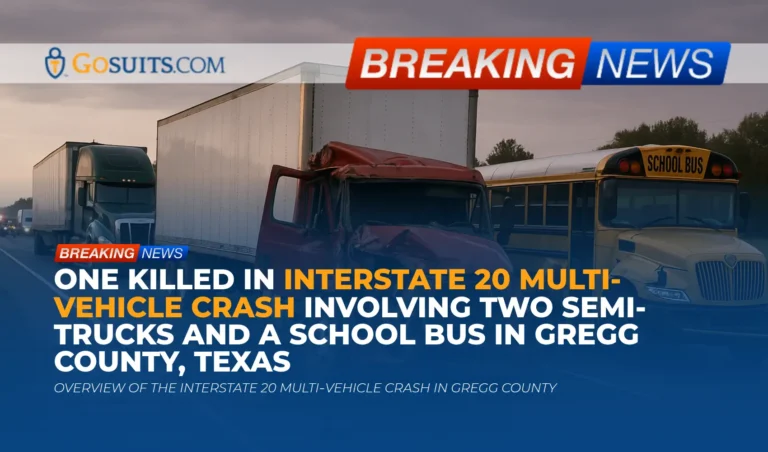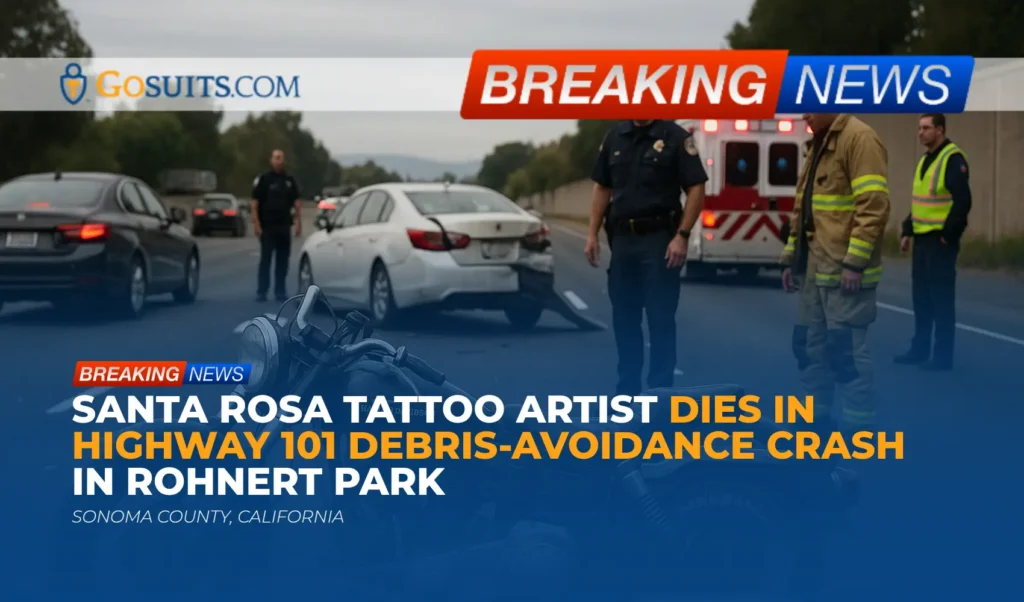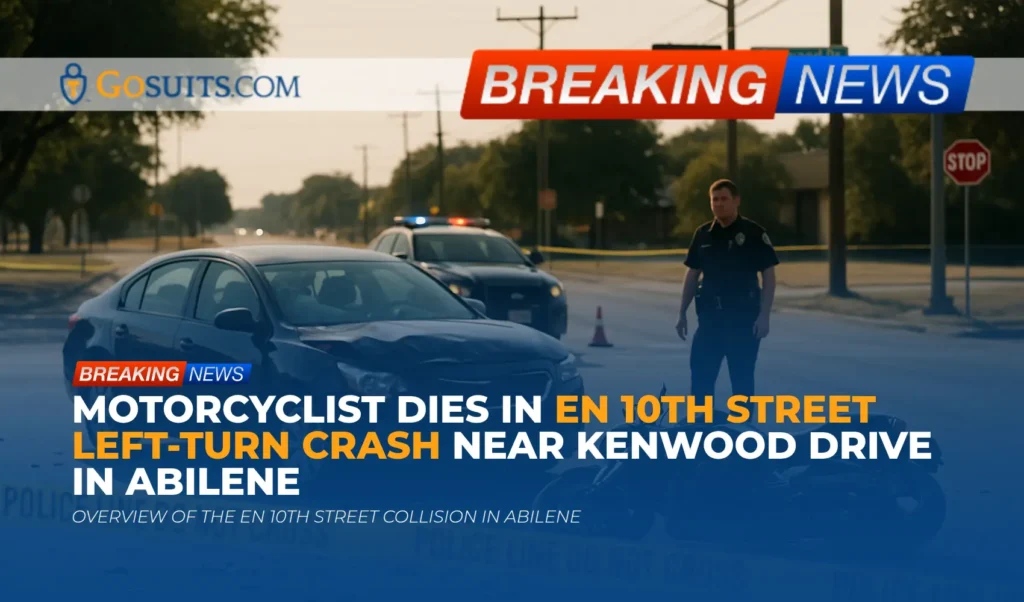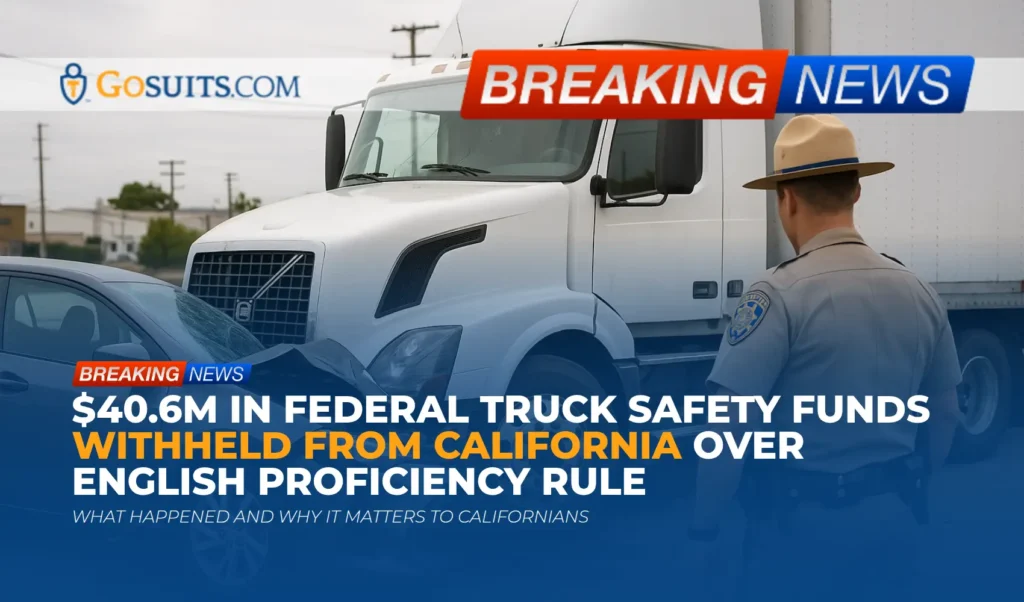- Overview of the Interstate 20 Multi‑Vehicle Crash in Gregg County
- What We Know So Far: Timeline and Vehicles Involved
- Which Agencies Are Involved and Where Families Can Obtain Records
- Understanding Fatal Multi‑Vehicle and Commercial Truck Collisions
- Potential Civil Liability Considerations After a Multi‑Vehicle Truck Crash
- Preserving Critical Evidence After a Serious Truck Crash
- Insurance and Financial Responsibility in Commercial Vehicle Crashes
- When a School Bus Is Involved: Governmental Immunity and Claims Nuances
- Data and Safety Insights on Large Trucks and School Buses
- How to Obtain the Crash Report, Autopsy or Inquest Records, and Towing/Vehicle Information
- Speaking With Insurance Companies: Why Caution Matters
- Commentary from Gosuits Gregg County, Texas Personal Injury Attorney
- Time‑Sensitive Action Steps and Why Acting Promptly Matters
Overview of the Interstate 20 Multi‑Vehicle Crash in Gregg County
A tragic multi‑vehicle crash occurred on Interstate Highway 20 in Gregg County, Texas, on October 14, 2025, at approximately 9:25 p.m. According to the preliminary account shared by state authorities, multiple westbound vehicles were involved, including two truck‑tractor semi‑trailers, a box van, and a school bus. The driver of the box van, a 42‑year‑old man from Euless, Texas, died at the scene. No other drivers or child passengers reported injuries. The Texas Department of Public Safety (DPS) is conducting the investigation, which remains ongoing.
For families, friends, and community members touched by this event, the facts can be painful to absorb. It is normal to have urgent questions: how the crash unfolded, what rights may exist, and how to obtain official records. The sections below aim to explain what is currently known, outline the civil law context that often applies in serious roadway crashes, and identify government sources and steps that can help those seeking clarity and support.
What We Know So Far: Timeline and Vehicles Involved
Based on the preliminary description provided by authorities:
- Direction of travel: All vehicles were traveling westbound on Interstate 20 in Gregg County.
- Sequence: A box van (Vehicle 1) struck the rear of a truck‑tractor semi‑trailer (Vehicle 2). The box van became disabled in the roadway and was then struck by a second truck‑tractor semi‑trailer (Vehicle 3). The impact pushed the box van into the path of a school bus (Vehicle 4), causing damage to the left side of the bus.
- Injury status: The driver of the box van was pronounced deceased at the scene. The other drivers and the child passengers onboard the school bus were reported uninjured.
- Status of investigation: The investigation is ongoing. Additional details, including final crash reconstruction findings, are not yet available.
It is common for commercial vehicle crashes to require extensive post‑scene investigation. Final determinations about causation, contributing factors, and any civil responsibility often depend on vehicle inspections, witness accounts, onboard data, camera footage, and compliance reviews under federal and state rules.
Which Agencies Are Involved and Where Families Can Obtain Records
Several public agencies typically generate or hold records after a fatal crash in Texas. The following sources are often essential:
- Texas Department of Public Safety (DPS): DPS leads many highway crash investigations. While DPS Troopers investigate, official crash reports are filed with the Texas Department of Transportation (TxDOT). DPS also may have incident reports and can confirm which Justice of the Peace or medical examiner’s office handled the inquest. Visit Texas DPS.
- Texas Department of Transportation (TxDOT) Crash Report: The formal CR‑3 crash report can be purchased once filed and approved through TxDOT’s system. See TxDOT’s guidance on obtaining crash reports here: TxDOT Crash Reports.
- Inquest and Autopsy Records: In Texas, inquest authority may rest with a Justice of the Peace or a county medical examiner depending on the county. Autopsy reports are public records under Texas law, with restrictions on photos and certain sensitive content. See Texas Code of Criminal Procedure, Article 49 and 49.25 regarding inquests and medical examiners: Tex. Code Crim. Proc. ch. 49. Autopsy reports are specifically addressed in Article 49.25, Section 11.
- Death Certificates: Certified copies are available through the Texas Department of State Health Services, Vital Statistics. See Texas DSHS Death Records.
- Towing and Vehicle Storage: If a vehicle was towed, location information may be found through the Texas Department of Licensing and Regulation vehicle storage facility locator: TDLR VSF Locator.
If the involved school bus is part of a public school district, there may also be district incident documentation and compliance reporting. Public records requests to the relevant district may be available under the Texas Public Information Act, although sensitive student information is protected.
Understanding Fatal Multi‑Vehicle and Commercial Truck Collisions
Large trucks and buses operate under stringent safety rules because of the potential severity of crashes. Federal Motor Carrier Safety Regulations (FMCSRs) govern commercial carriers nationwide. In multi‑vehicle chain‑reaction events, several factors may be examined, including speed, following distance, visibility, lighting, vehicle condition, load security, driver fitness and alertness, and whether hazard devices were deployed when a vehicle became disabled in a travel lane.
When a vehicle becomes disabled in the roadway, federal regulations require specific hazard precautions. Under 49 CFR 392.22, a commercial driver who stops a vehicle on the traveled portion or shoulder of a highway must immediately activate hazard warning flashers and, within 10 minutes, place required warning devices to alert other road users, with particular rules on spacing depending on roadway type and conditions. See the regulation at 49 CFR 392.22.
Investigations may consider whether the initial rear‑end impact left the box van inoperable, whether subsequent drivers had adequate time and distance to avoid a disabled vehicle, and whether required warnings were feasible under the circumstances. Chain‑reaction events can present complex questions about who had the last clear chance to avoid impact and what actions were reasonable in the moment.
Potential Civil Liability Considerations After a Multi‑Vehicle Truck Crash
The civil law analysis after a crash like this is fact‑intensive. While every case turns on its specific evidence, several general principles often apply in Texas:
- Rear‑End Collisions: Rear‑end impacts commonly raise questions about following distance, speed, and attention. However, Texas law evaluates negligence comparatively, accounting for each party’s share of responsibility.
- Comparative Responsibility: Texas uses proportionate responsibility. If a claimant is found more than 50 percent responsible, recovery may be barred. See Texas Civil Practice and Remedies Code §33.001.
- Commercial Carrier Duties: Motor carriers must train, supervise, and maintain safe operations. Potential theories in serious truck crashes can involve negligent operation, hiring, retention, training, entrustment, and maintenance. Compliance with FMCSRs is often a key evidence area.
- Stopped Vehicle Hazard Compliance: Whether a disabled commercial vehicle’s driver could and did deploy hazard flashers and warning devices as required by 49 CFR 392.22 may be relevant, though feasibility depends on the facts. Investigators also consider lighting conditions and sight distance at night.
- School Bus Involvement: If a public school district bus is involved, claims issues may be affected by the Texas Tort Claims Act’s notice requirements and liability limits, discussed further below.
- Wrongful Death and Survival Claims: In Texas, certain family members may pursue wrongful death claims, and the decedent’s estate may pursue survival claims on behalf of the decedent. See Texas Civil Practice and Remedies Code §71.004 and §71.021.
- Time Limits: Most wrongful death and personal injury claims in Texas must be filed within two years of the incident. See Texas Civil Practice and Remedies Code §16.003. Certain governmental claims also require earlier notice, addressed below.
It is important not to draw conclusions about fault before the official investigation concludes and all relevant evidence is preserved and reviewed. Multi‑impact sequences can involve multiple contributing causes and legal questions about each driver’s duty at specific moments.
Preserving Critical Evidence After a Serious Truck Crash
Early preservation of evidence can be crucial in crashes involving commercial vehicles. Some data is routinely overwritten by carriers if not preserved in time. The following items are frequently sought:
- Electronic Logging Device (ELD) and Hours‑of‑Service Records: These can indicate driver duty status, rest breaks, and potential fatigue issues. Motor carriers must retain certain hours‑of‑service records for at least six months. See FMCSA ELD Rule.
- Event Data Recorder (EDR/ECM) and Telematics: Engine control module data, braking, speed, and throttle inputs may be available depending on vehicle make and model. Preservation often requires prompt notice to prevent loss during repairs or salvage.
- Dash and Cab Cameras: Many fleets use inward and outward‑facing cameras. These may be automatically overwritten within days or weeks absent a preservation request.
- Driver Qualification and Maintenance Files: Training, licensing, prior incidents, and vehicle inspection and repair logs can bear on safety compliance.
- Roadway and Scene Evidence: Skid marks, debris fields, and lighting conditions are best documented quickly. Weather and traffic data may also be relevant.
A formal preservation letter is commonly used to notify involved parties to maintain relevant materials. Timeliness is key because certain electronic systems overwrite data on short cycles, and federal retention rules set minimum periods that are not indefinite.
Insurance and Financial Responsibility in Commercial Vehicle Crashes
Commercial motor carriers engaged in interstate commerce must carry minimum levels of financial responsibility. For most general freight carriers operating interstate, federal rules require at least $750,000 in liability coverage, with higher limits for certain cargo and hazardous materials. See FMCSA Financial Responsibility and 49 CFR Part 387.
Other coverages may be relevant in a multi‑vehicle crash:
- Commercial Auto Liability for tractor‑trailers, box vans, and fleet vehicles.
- Uninsured/Underinsured Motorist (UM/UIM) coverage on applicable policies.
- Medical Payments/Personal Injury Protection where available on personal policies.
- Governmental entity coverage and liability caps if a public school district vehicle is involved under the Texas Tort Claims Act.
Insurance arrangements can be intricate in multi‑vehicle events. Priority of coverage, indemnity provisions, and cross‑claims often require careful review of policy language and statutory frameworks.
When a School Bus Is Involved: Governmental Immunity and Claims Nuances
If a public school district bus is involved in a collision, claims may be governed in part by the Texas Tort Claims Act (TTCA). Key points often include:
- Notice Requirements: Written notice to the governmental unit may be required within six months of the incident, describing the damage or injury, time and place, and incident facts. See Texas Civil Practice and Remedies Code §101.101. Some local charters impose even shorter deadlines.
- Liability Limits: Damage caps apply. For many local governmental units, including school districts, the cap is generally $100,000 per person and $300,000 per occurrence for bodily injury and $100,000 for property damage. See §101.023.
- Scope of Waiver: The TTCA waives immunity for certain motor‑vehicle‑related negligence by employees acting within the scope of employment, subject to statutory limits and defenses.
Because the children on the bus were reported uninjured, immediate medical claims tied to the bus may not arise. However, property damage or other related issues can still be affected by TTCA rules. Timely notice preserves options if injuries manifest later or if claims otherwise become necessary.

Data and Safety Insights on Large Trucks and School Buses
Understanding broader safety data can provide context to a single crash:
- Large Truck Crashes: Nationally, large trucks are involved in a disproportionate share of fatal crashes relative to their numbers on the road, largely due to their size and stopping distances. See NHTSA Large Trucks for data and safety analyses.
- School Bus Safety: NHTSA notes that school buses are among the safest vehicles on the road for children, with strong occupant protection and specialized driver training. See NHTSA School Bus Safety.
While national data is informative, each crash requires a fact‑specific analysis that considers vehicle positions, lighting, reaction times, compliance with federal and state safety rules, and the interplay of sequential impacts.
How to Obtain the Crash Report, Autopsy or Inquest Records, and Towing/Vehicle Information
Texas Crash Report (CR‑3)
The official crash report prepared by DPS and filed with TxDOT will typically be available for purchase once processed. Steps:
- Monitor availability and purchase the report through TxDOT’s system: TxDOT Crash Reports.
- Have key identifiers ready, such as the crash date (October 14, 2025), location (Interstate 20, Gregg County), and involved parties.
- Request any supplemental materials, if available, such as photographs or diagrams, recognizing that some items may require separate requests or may not be publicly releasable.
Crash reports often include a narrative, diagram, vehicle positions, weather and lighting conditions, and preliminary contributing factors. These documents can help clarify the basic sequence, though they may be updated if new information emerges.
Inquest and Autopsy Records
In fatal roadway incidents, Texas law requires an inquest. Depending on the county, this may be conducted by a Justice of the Peace or a medical examiner. Autopsy reports are public records, though photographs and certain sensitive materials are restricted. For legal framework, see Texas Code of Criminal Procedure ch. 49 and Article 49.25.
Practical steps:
- Identify the inquest authority that handled the case in Gregg County; DPS or local county offices can confirm which office has custody of records.
- Request the autopsy report from the appropriate office, following their procedures for public records. Be prepared for processing time.
- Obtain certified death certificates through the Texas Department of State Health Services: DSHS Death Records.
Towing and Vehicle Location
If an involved vehicle was towed from the scene, its location can often be found via the Texas Department of Licensing and Regulation’s vehicle storage facility locator: TDLR VSF Locator. Prompt retrieval is important both for personal reasons and to allow inspection before repairs, salvage, or disposal alter or eliminate key evidence.
Speaking With Insurance Companies: Why Caution Matters
Insurance representatives may request recorded statements and quick authorizations. In serious, multi‑party collisions, statements can be used later to limit or challenge claims. It is generally prudent to understand rights and obligations before giving statements, signing medical authorizations, or accepting any payment. What is said early on can carry significant consequences if later misinterpreted.
In particular, when government entities or multiple commercial carriers are involved, claim routing, deadlines, and coverage interactions can be complicated. Consulting with a seasoned attorney before speaking to any insurer can help avoid avoidable missteps, especially because TTCA notice deadlines and evidence preservation issues can arise quickly.
Commentary from Gosuits Gregg County, Texas Personal Injury Attorney
Our thoughts are with everyone affected by this interstate crash, especially the family of the driver who lost his life. The information here is intended for educational purposes and general understanding during a difficult time.
From a civil injury and wrongful death perspective, this sequence raises several familiar questions: how the first rear‑end impact occurred, the visibility and lighting on the roadway at that hour, whether a disabled vehicle could be seen and avoided by following traffic, and whether required warnings could be deployed. When school transportation is in the mix, layers of governmental liability rules apply, even if no injuries are reported among students.
In our experience, insurers and large companies move quickly to frame the narrative and secure their own evidence. People touched by tragedy often do not realize how fast electronic data can be overwritten or how a simple recorded statement can be used against them later. Understanding the rules of the road, the federal safety regulations that apply to commercial fleets, and Texas timelines for filing and notice can make a critical difference.
A no‑cost consultation is a practical step to gain clarity on rights, preservation of evidence, and deadlines. It can help ensure that choices are informed and that important documents and data are not lost while the official investigation continues.

Time‑Sensitive Action Steps and Why Acting Promptly Matters
The following are concrete, time‑sensitive steps that can protect options and preserve clarity in the wake of a serious crash:
- Secure the official crash report: Obtain the TxDOT CR‑3 report as soon as it becomes available. It provides the baseline narrative and diagram used by many insurers to evaluate claims.
- Request inquest/autopsy materials: Autopsy reports and related inquest documentation provide medical findings that can be essential to any later civil claim.
- Preserve vehicle data: Ensure that vehicles are not destroyed or repaired before necessary inspections. Request preservation of ELD, ECM, telematics, and camera footage. Electronic data can be overwritten in days or weeks.
- Document the scene and conditions: Collect photographs of vehicle damage, roadway lighting, sight lines, and any relevant signage. Do this promptly, as conditions can change quickly.
- Track medical and counseling records: Keep organized records of any medical evaluations, grief counseling, or other services. These records support understanding of impacts over time.
- Meet legal timelines: Be aware of the general two‑year limitations period for wrongful death and personal injury in Texas, and the shorter notice requirements for claims involving governmental entities like school districts.
- Consult before speaking with insurers: Engage with a qualified attorney before giving recorded statements or signing authorizations. Statements made to insurance companies can later be used to challenge or limit recovery.
Why urgency matters:
- Evidence evaporates: Electronic data cycles, camera overwrites, and vehicle disposal can erase critical proof.
- Deadlines apply: Statutes of limitations and governmental notice rules can shorten options unless timely action is taken.
- Narratives form early: Insurers often assemble their view of events quickly; timely access to objective records helps balance the picture.
Additional Legal Framework and Public Resources
For those who wish to read the governing statutes and federal rules discussed above:
- Texas Wrongful Death and Survival: CPRC §71.004 and §71.021.
- Texas Limitations: CPRC §16.003.
- Proportionate Responsibility: CPRC §33.001.
- Texas Tort Claims Act: Notice and liability caps at CPRC §101.101 and §101.023.
- Inquests and Autopsies: Tex. Code Crim. Proc. ch. 49 and art. 49.25.
- FMCSA Hazard Warning Devices for Stopped Commercial Vehicles: 49 CFR 392.22.
- FMCSA ELD and HOS Retention: ELD Rule Overview.
- FMCSA Financial Responsibility: Carrier Minimums and 49 CFR Part 387.
- NHTSA Large Trucks: Safety Data.
- NHTSA School Bus Safety: Overview.
- TxDOT Crash Reports: Purchase and Access.
- TDLR Vehicle Storage Facility Locator: Find Towed Vehicles.
- Texas DSHS Death Records: Order Certified Copies.
These official resources can help ensure that information relied upon is accurate and up to date, and they provide the statutory background that often applies in multi‑vehicle, commercial transportation crashes.






